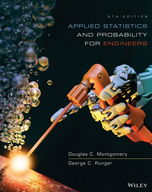Solution Found!
Magnesium alkyls are used as homogenous catalysts in the
Chapter 2, Problem 69E(choose chapter or problem)
Problem 69E
Magnesium alkyls are used as homogenous catalysts in the production of linear low-density polyethylene (LLDPE), which requires a finer magnesium powder to sustain a reaction. Redox reaction experiments using four different amounts of magnesium powder are performed. Each result may or may not be further reduced in a second step using three different magnesium powder amounts. Each of these results may or may not be further reduced in a third step using three different amounts of magnesium powder.
(a) How many experiments are possible?
(b) If all outcomes are equally likely, what is the probability that the best result is obtained from an experiment that uses all three steps?
(c) Does the result in part
(b) change if five or six or seven different amounts are used in the first step? Explain.
Questions & Answers
QUESTION:
Problem 69E
Magnesium alkyls are used as homogenous catalysts in the production of linear low-density polyethylene (LLDPE), which requires a finer magnesium powder to sustain a reaction. Redox reaction experiments using four different amounts of magnesium powder are performed. Each result may or may not be further reduced in a second step using three different magnesium powder amounts. Each of these results may or may not be further reduced in a third step using three different amounts of magnesium powder.
(a) How many experiments are possible?
(b) If all outcomes are equally likely, what is the probability that the best result is obtained from an experiment that uses all three steps?
(c) Does the result in part
(b) change if five or six or seven different amounts are used in the first step? Explain.
ANSWER:
Answer
Step 1 of 3
(a)
We are asked to find the number of experiments which are possible.
Redox reaction experiments using four different amounts of magnesium powder are performed.
Hence in this case number of experiments is .
Each result may or may not be further reduced in a second step using three different magnesium powder amounts.
Hence in this case number of experiments is [since it may happen or may be not]
Similarly, each result may or may not be further reduced in a third step using three different magnesium powder amounts.
Hence in this case number of experiments is [since it may happen or may be not]
Therefore, the total number of experiments,
Hence the total number of experiments which are possible is
